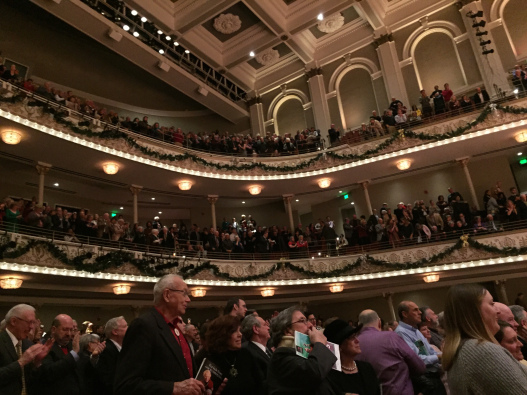 A large crowd was on hand to hear the popular “Pictures at an Exhibition”
A large crowd was on hand to hear the popular “Pictures at an Exhibition”
A crowd-pleasing program and a rare trumpet soloist added up to an electric evening at the Cincinnati Symphony orchestra on Saturday.
Music Hall was fairly full for Saturday’s concert, which was highlighted in the second half by a magnificent performance of Mussorgsky’s “Pictures at an Exhibition” in the well-known Ravel orchestration. There was also a remarkable performance by Norwegian trumpeter Tine Thing Helseth, who made her Cincinnati debut in Arutiunian’s Trumpet Concerto in A-flat Major.
But first, the program, led by guest maestro Andrey Boreyko, opened with another rarity: Stravinsky’s Funeral Song of 1908. The somber but beautiful piece, written in homage to Rimsky-Korsakov, was lost for more than 100 years and only discovered in 2015 at the St. Petersburg Conservatory. Its phrases were reminiscent of Stravinsky’s early Russian ballets, with sweeping, bold themes for the horns and lyrical writing for the winds. Boreyko conveyed its sense of tragedy and drama, particularly near the end, in which dark chords in the brass punctuated a series of intense string tremolos.
 Norwegian trumpeter Tine Thing Helseth
Norwegian trumpeter Tine Thing Helseth
For the program’s centerpiece, Helseth scampered onstage barefoot, lifted her trumpet, and dazzled in a virtuoso performance of Arutiunian’s Trumpet Concerto. The flashy piece had many moments that called for rapid tonguing and other technical feats, but she tossed them off easily. It was impressive to hear her silvery tone and lovely phrasing in the work’s soulful, folk-like melodies. Boreyko and the orchestra supported her well.
For an encore, she announced a Norwegian Christmas carol that roughly translates into “My Heart is Ever Present,” which she has also recorded. It was haunting and lovely, and then the barefoot maiden waved and walked off the stage. (It’s interesting that about two weeks ago, pianist Alice Sara Ott also gave a barefoot performance. Maybe it’s a new trend?)
 Boreyko in his third appearance with the Cincinnati Symphony Orchestra
Boreyko in his third appearance with the Cincinnati Symphony Orchestra
Boreyko, making his third appearance as guest conductor, is music director of the Artis-Naples (Florida), home of the Naples Philharmonic. His leadership throughout the evening was intelligent and clear. His podium style, vividly etching each phrase in his gestures, brought out the best in the players.
I especially enjoyed the way he paced Mussorgsky’s “Pictures,” taking his time in the Promenades that occur between each picture to perfectly set up each mood. There was considerable drama and mystery in “Gnomus,” and stunning lightness in “Tuileries.” “The Ballet of Unhatched Chicks” was both unrushed and humorous; “Catacombs” was spellbinding for its powerful, spacious brass chords.
The conductor transitioned seamlessly from the terrifying tale of Baba Yaga to the majestic “Great Gate of Kiev.” Many orchestral soloists shone in this performance, notably principal bassoonist William Winstead and the CSO’s principal trumpeter-designate Robert Sullivan.
Acoustically, I had yet another impression of the “new” Music Hall. My seat near the front on right side of the main floor was surprisingly good for listening. Textures were clear and not overly bright. The brass and timpani on the upper riser were in good balance, and didn’t overpower – especially in the sonic glory of the “Great Gate of Kiev,” ablaze in brass and chimes.
It was a different kind of sonority – not with the old Music Hall warmth and resonance, but still very good. Looking up, I noticed that I was very close to the glass acoustical clouds. I’m wondering if the main floor is getting all of the benefit of that sound reflection, but the other floors, maybe not so much.
I was sitting so close to the stage, that I could almost read the second violin parts. Unfortunately, sightlines from my seat were poor, despite the new risers for the players. I could really only see the strings.
It’s food for thought, and does indicate that the quality of the experience in Music Hall — now more than ever before — depends upon where you sit.
The concert repeats at 2 p.m. Sunday. Information: cincinnatisymphony.org
Advertisements Share this:






